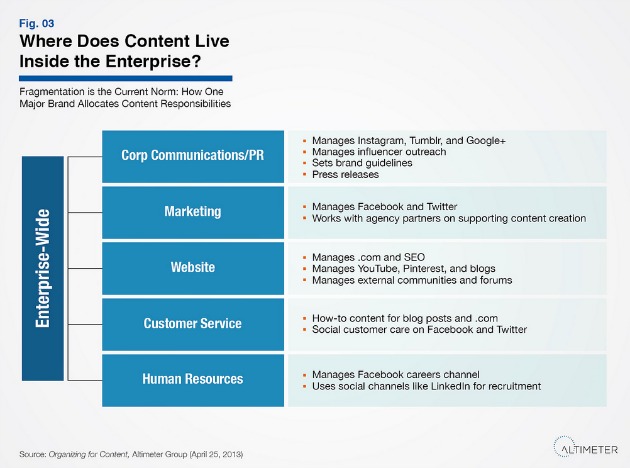
Why is content orchestration needed across the organization — all departments included, no exceptions? Here’s a recent example of a near-missed opportunity.
 The client recently launched a content marketing initiative, one that’s rich in blog entries and videos around health and wellness. Six months into the program, which is governed by the social media marketing department, the metrics all look good: repeat visits, brand favorability, page views — so much so that the program will be expanded with a site redesign and new features.
The client recently launched a content marketing initiative, one that’s rich in blog entries and videos around health and wellness. Six months into the program, which is governed by the social media marketing department, the metrics all look good: repeat visits, brand favorability, page views — so much so that the program will be expanded with a site redesign and new features.
One planned new feature is giving readers the ability to subscribe to email updates. The social team did some digging and learned the company is already working with a major email service provider, so the machinery is in place to add that ability.
This is where it bears mentioning that this particular organization is in a highly regulated industry. Marketing activities can only be conducted in certain states. Moreover, different brands of the parent enterprise come into play on a state-by-state basis. To say marketing for this organization is highly segmented is an understatement.
Clearly, because what’s at play here is content marketing, the sell is soft. In fact, it’s non-existent in terms of this particular content initiative. Yet it’s possible that could change, or that the company might elect to add a link, a call-to-action, or a promotional “brought to you by” message in the footer of the subscription emails.
All that’s possible, and more. Subscribers could be asked to indicate in which state they reside when signing up for the emails. Email append could be used on the list to segment subscribers on a state-by-state basis in order to insert the relevant brand name into the messages.
All these ideas are as possible as they are (for now) theoretical. Yet none were entertained by the social media department running the campaign. This would very likely be to the chagrin of the email division, or the direct marketing group, had they known of the plans afoot (which, of course, they do not).
This is only one recent, real-life example of why organizations must organize for content. Without cross-functional communication, coordination, expertise, and goal-sharing, companies are doomed to be mired in inefficiencies, missed opportunities, reduplicated efforts, and just plain not sharing the very high levels of expertise inherent in the broad array of digital practice areas.
How to organize is, of course, the question. Few enterprises have a formal content division or an executive expressly charged with overseeing content initiatives. Recently, research I conducted included asking 78 companies how they’re tackling the content issue. Only nine of them have, to date, made express content-related hires (i.e., people with titles containing “content” or “editor”).
Unsurprisingly, this leads to ad hoc content and content responsibilities that tend to be based more on factors like hand-raising than expertise or strategy. Case in point, here’s how one major brand has allocated content responsibilities:
Yes, models have emerged to address the need to synchronize, manage, coordinate, and optimize content strategy, creation, production, and distribution. Not all of these frameworks necessitate increasing headcount, a solution that at the majority of organizations is quickly filed under “easier said than done.”
Read the rest of this post on iMedia Connection, where it originally published.
